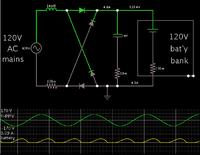DC177E
Newbie level 6
Hello,
We have an electric car project which has 8-10 12v SLA batteries in series as a power source. In order to charge this, we need a ~120v ~15a DC power supply to feed into a custom board that controls current and such via mosfet. Because of the high power, we were thinking of just taking the output from a 1:1 transformer (for safety) and rectifying it. Unfortunately, we cannot find any appropriately priced (<120$) transformers suitable for 13-15a. If anyone knows where we could find one such transformer, or has a better idea as to a power supply, we would appreciate it.
Thanks,
Dan
We have an electric car project which has 8-10 12v SLA batteries in series as a power source. In order to charge this, we need a ~120v ~15a DC power supply to feed into a custom board that controls current and such via mosfet. Because of the high power, we were thinking of just taking the output from a 1:1 transformer (for safety) and rectifying it. Unfortunately, we cannot find any appropriately priced (<120$) transformers suitable for 13-15a. If anyone knows where we could find one such transformer, or has a better idea as to a power supply, we would appreciate it.
Thanks,
Dan
